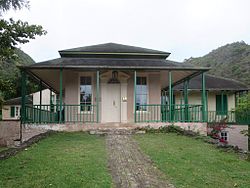Briars, St Helena
| Briars | |
|
' | |
|---|---|
 Briars Pavilion | |
| Location: | -15.943472 -5.70972 |
| Information | |
| Owned by: | Government of France |
Briars is the name of the small pavilion in which Napoleon Bonaparte, the deposed Emperor of the French, stayed for the first few weeks of his captivity on St Helena. In 1959 it was sold to the Government of France, and is managed on their behalf by the St Helena National Trust.
The pavilion was in the garden of William Balcombe, an English merchant who became a purveyor to Napoleon. His 14-year-old daughter, Elizabeth Lucia ("Betsy") Balcombe, was the only family member who spoke French and she became the family translator. Because of his family's closeness to Napoleon, Balcombe attracted the suspicion of Governor Hudson Lowe, and in 1818 he was forced to leave the island and return to Britain.[1]
The Briars then was used as the home for the Admiral on duty in the station.[2]
Balcombe bever forgot his St Helenian home and when he was assigned to a post in Australia, he established a new estate called "The Briars" in the Carwoola area of New South Wales. On this new estate, it is believed that William Snr was responsible for introducing two plants to Australia, the Sweet Briar (Rosa Rubiginosa) and the Weeping Willow (Salix Babylonica). The willow grew nearby Napoleon’s grave on St Helena and Balcombe is reported to have taken cuttings from these trees.[3]
In 1959 the Pavilion was offered to the French government by a descendant of William Balcombe, Dame Mabel Brookes, and became the third of the French properties on the island, now known as the Domaines Français.
See also
References
- ↑ Abell, Lucia Elizabeth Balcombe, To Befriend an Emperor: Betsy Balcombe's Memoirs of Napoleon on St. Helena. Welwyn Garden City, UK: Ravenhall, 2005. ISBN 1905043031.
- ↑ The main habitations and their occupants, during Napoleon's captivity
- ↑ Johnston, T.A.: The Radcliffe Community Bicentennial Cook Book, 1988. Carwoola History